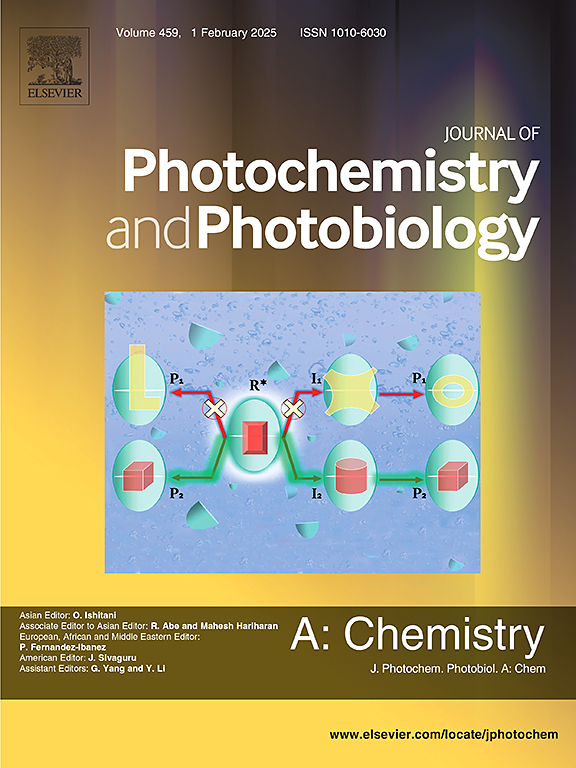Construction of dehydroabietic acid triarylamine-based “ESIPT + AIE” type molecule for “On-Off” sensing of Cu2+ and anti-counterfeiting
IF 4.7
3区 化学
Q2 CHEMISTRY, PHYSICAL
Journal of Photochemistry and Photobiology A-chemistry
Pub Date : 2025-06-13
DOI:10.1016/j.jphotochem.2025.116565
引用次数: 0
Abstract
A novel compound, DTPA-HBT, based on dehydroabietic acid triarylamine and benzothiazole, was designed and synthesized, exhibiting dual characteristics of aggregation-induced emission (AIE) and excited-state intramolecular proton transfer (ESIPT). The DTPA-HBT exhibits a large Stokes shift (up to 280 nm), and experimental and theoretical studies confirm the synergistic interaction between AIE and ESIPT. The theoretical calculations reveal that the intramolecular hydrogen bonding plays a critical role in the ESIPT process, and the molecule’s excited state exhibits a twisted conformation and a planar structure conducive to proton transfer, facilitating the manifestation of both AIE and ESIPT characteristics. Additionally, DTPA-HBT not only serves as a fluorescent probe for the specific detection of Cu2+ but also demonstrates its utility in fluorescence-based anti-counterfeiting applications, showcasing its potential as an effective fluorescent material for practical applications.

基于脱氢枞酸三芳胺的“ESIPT + AIE”型Cu2+开关感应及防伪分子的构建
设计并合成了以脱氢枞酸三芳胺和苯并噻唑为基础的新型化合物DTPA-HBT,该化合物具有聚集诱导发射(AIE)和激发态分子内质子转移(ESIPT)的双重特性。DTPA-HBT表现出较大的Stokes位移(高达280 nm),实验和理论研究证实了AIE和ESIPT之间的协同相互作用。理论计算表明,分子内氢键在ESIPT过程中起着至关重要的作用,分子激发态呈现扭曲构象和有利于质子转移的平面结构,有利于AIE和ESIPT特性的同时表现。此外,DTPA-HBT不仅可以作为Cu2+特异性检测的荧光探针,而且还展示了其在基于荧光的防伪应用中的实用性,显示了其作为实际应用的有效荧光材料的潜力。
本文章由计算机程序翻译,如有差异,请以英文原文为准。
求助全文
约1分钟内获得全文
求助全文
来源期刊
CiteScore
7.90
自引率
7.00%
发文量
580
审稿时长
48 days
期刊介绍:
JPPA publishes the results of fundamental studies on all aspects of chemical phenomena induced by interactions between light and molecules/matter of all kinds.
All systems capable of being described at the molecular or integrated multimolecular level are appropriate for the journal. This includes all molecular chemical species as well as biomolecular, supramolecular, polymer and other macromolecular systems, as well as solid state photochemistry. In addition, the journal publishes studies of semiconductor and other photoactive organic and inorganic materials, photocatalysis (organic, inorganic, supramolecular and superconductor).
The scope includes condensed and gas phase photochemistry, as well as synchrotron radiation chemistry. A broad range of processes and techniques in photochemistry are covered such as light induced energy, electron and proton transfer; nonlinear photochemical behavior; mechanistic investigation of photochemical reactions and identification of the products of photochemical reactions; quantum yield determinations and measurements of rate constants for primary and secondary photochemical processes; steady-state and time-resolved emission, ultrafast spectroscopic methods, single molecule spectroscopy, time resolved X-ray diffraction, luminescence microscopy, and scattering spectroscopy applied to photochemistry. Papers in emerging and applied areas such as luminescent sensors, electroluminescence, solar energy conversion, atmospheric photochemistry, environmental remediation, and related photocatalytic chemistry are also welcome.

 求助内容:
求助内容: 应助结果提醒方式:
应助结果提醒方式:


